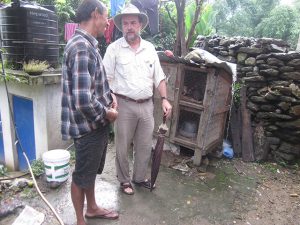
As part of our Sherpa Night on October 26 in Raleigh, Dr. Steve Folmar, associate professor in the Department of Cultural/Applied Anthropology at Wake Forest University in Winston-Salem, will discuss the evolution and role of clothing in Nepalese culture. He gives us a sneak preview of his talk below.
Steve Folmar doesn’t believe that wardrobe alone can tear down the partitions of discrimination. But he does feel it can play a role.
Folmar, associate chair of the Department of Cultural/Applied Anthropology at Wake Forest University, has spent 38 years doing research in Nepal. His first visit was in 1979, as a student at Case Western Reserve University working on his dissertation. He stayed in the country, taking particular interest in social status and medical and psychological anthropology for a year and a half.
“I enjoyed my time there,” says Folmar, “but I was ready to go home.”
It wasn’t long, though, before he realized he needed to return.
“It was the people,” he says. “The environment was spectacular,” he notes, “no doubt about it. But they reach out to other people in a more in-depth and intense way than they do here. They know their neighbors … . They express a great deal of appreciation for you visiting their country, for your interest in their culture.
“It’s hard not to love a people like that.”
One of the things he observed during his visits was the abundance of tailors, and that many people — in the cities, at least — wore hand-made clothing. That, says Folmar, was a holdover from the patron/client days, when when servants also made clothes for their employers.
They also wore more traditional dress.
“When I was first there, 90 percent more women dressed in traditional dress that reflected their ethnic caste identification. About 50 percent of men did as well. Over time, the society became more globalized, wearing jeans, short skirts. It was a reflection of historical change.”
It also made it harder to identify where someone stood in the pecking order, and thus to discriminate against people in the country’s still regimented caste system.
The change was different in the higher altitudes, where Sherpa clothing reflected the higher, colder, harsher weather. “Out of necessity, they wore skins and furs, boots and hats. It was amazing the different styles and color.”
“Today,” he adds, “the men wear more modern western wear like what you’d find at Great Outdoor Provision.” Based on clothing, at least, it’s hard to tell the Sherpas from their western clients. Lighter, better performing clothing — again, suitable for the harsh environment — has helped to drive that change.
Folmar is quick to note that while the evolution of dress “appears to have had a leveling effect, it’s secondary to other forces that might help level things: education, health care, access to political offices, leveling the religious landscape.”
He also notes that the trend is hardly unique to Nepal.
“You go to Silicon Valley and it’s hard to identify the wealthy,” he says. “They wear the same kind of thing I wear. Except maybe better brands.”
* * *
Sherpa Night
When: Thursday, Oct. 26, 6-8 p.m.
Where: Our store in Raleigh’s Cameron Village, 2017 Cameron St.
Cost: free
What it’s about: With Sherpa Adventure Gear, we’ll celebrate Himalayan culture with traditional Nepali food and festivities. In addition to Dr. Folmar, we’ll hear the Sherpa Adventure Gear story, about the company’s background, where they came from and how they give back to their communities in Nepal.
More info and RSVP here.
